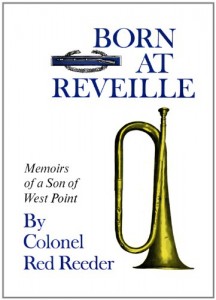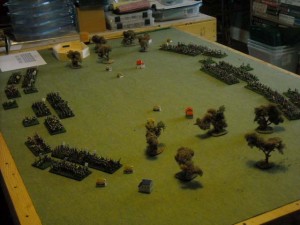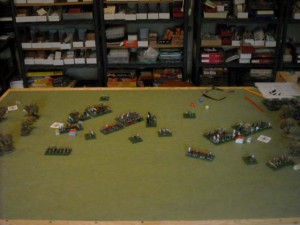While planning for my 2014 gaming projects, one of the topics under consideration was Napoleon in Egypt. A colorful topic and one that doesn’t require a large number of figures for an enjoyable game. One can even re-use figures form 25mm Colonial armies.
Presented for your reading pleasure is an article from May of 1967, by none other than Jack Scruby.
A Napoleonic Colonial War Game
By Jack Scruby
Miniature Parade May 1967
As an old Napoleonic war gamer – plus having a great love for African Colonial war games, I have long looked for a combination Napoleonic – Colonial game which would combine the features of both. And I think I have found it, and I believe many of those who have the Napoleonic bug will be interested in the possibilities of a game such as this. The idea is that if you are becoming bored with the big European type game, you can set it off occasionally with an African colonial campaign of the same period. But, with a large difference in tactics, rules and organization of your troops.
Since designing the new Scruby 25mm soldiers of Napoleon’s campaign in Egypt, 1798-1801, I have been working on organizing and painting an army of these figures, and am looking forward to their I completion and some different kind of war games. Although these model soldiers are based on historic fact, I shall, however, play my colonial war on a non-historical basis, which I think is going make it a very satisfying war game.
THE ORGANIZATION OF THE ARMIES
Basically, this will be a French versus British war (in Egypt of course) of the 1800 period (the very early Napoleonic era). Added to the British side will be native troops, while the French will have some irregular troops as their allies.
Both forces will be organized on a company basis. As with my 1880 African Colonial armies, a 3 inch by 2 inch balsa wood stand will hold 10 infantry soldiers (6 in the front rank, 4 in the back, with space in the center to mark the roster number of the stand), representing (on a 1 soldier equals 10 historical soldiers basis) 100 men – or a company.
A demi-brigade of French will be 9 companies strong, with 1 Grenadier company and 8 Fusilier companies. Light Infantry types will either be natives, or will be a detached company or two from a Light Infantry demi-brigade.
The value of a stand will be set at 100, with firepower set at a basic 20 kills when at full strength. Morale values will be assessed to each stand also, depending on the type of troop it is, with the Grenadier stand, of course, having the highest morale values, on down to Native irregular infantry with low morale standards.
The British infantry will be set up in the same manner, there being 10 companies per battalion (1 grenadier, 1 light company and 8 battalion companies. Turkish regulars will also represent 100 man companies, and will have Askari (trained native troops of the 1880s) firepower, movement and morale. Their morale and firepower is less than the French or British, but their movement is faster, which gives them the status of a non-elite type light infantry in fact.
Egyptian or Turkish irregular infantry will be set up on a 15 man stand, 3 inches long by 1 inch wide, representing 50 men and with low morale, fast movement, and low firepower. Besides these, there will be Arabian or Egyptian spearmen, with no muskets, for use as mass troops – highly unreliable as far as morale goes, but very good in close hand-to-hand fighting.
During the Egyptian campaign of Napoleon, cavalry were limited as far as the French and British were concerned, and here I intend to stay within historical bounds. The French brought along Dragoons and a few Chasseurs a Cheval, plus some 300 of Napoleon’s personal Guides.
The Guides, mounted 4 figures to a stand, will be the elite cavalry (with Guard status), while the Dragoons (again 4 to a stand) are the heavy line cavalry, with good hand-to-hand fighting ability. The Chasseurs (mounted 3 per stand) are the light cavalry of course, with swift movement, some carbine fire capabilities, but not too good at melee work except under good conditions.
The British had along their Light Dragoons, and these will be mounted to indicate that they are light cavalry (i.e. 3 models per stand). Their capabilities will be the same as the French Chasseurs. The Mamelukes will become the British heavy cavalry arm, and I have mounted them 4 per stand, and there will be quite a number of them available to the British force. These men, historically, were demons once they got into melee, and my rules will reflect this, and they should be excellent troops I think, since we are assuming that a British commander will be using them somewhat more craftily than did the Egyptians in the actual campaign!
Light Cavalry, of course, will have greater movement than the Heavy Cavalry, but the fastest moving cavalrymen will be the native irregular light cavalry, which will include Bedouins, Arabs and Turks. These men will have lower morale value than our white cavalry, but can use musket fire from the saddle, and should be great for harassing purposes in any war game. `
Artillery will be limited (as in all our colonial games) since it was difficult to drag heavy guns around in the desert areas. However, what guns are available, will be worthwhile having, and I mount these on a small stand with two or three crewmen around the gun to give it a realistic appearance.
As many readers can probably tell, this Napoleonic colonial army is based on my 1880 Colonial organization which I have reported before in Table Top Talk over the past couple of years. And it may seem that playing a Napoleonic colonial war game and an 1880 colonial game would wind up to be the same thing. But this is not true.
For, in 1880 the rifle could stop the natives several hundred yards away from the front line – but in 1800, the musket was not useful or accurate much above 40 to 50 yards. Therein lies the story which makes these two periods so totally different in tactics.
For example, in our 1880 colonial wars, our musket range is 20 inches (comparable to our infantry move of 4 inches). In our 1799-1800 game, this range will be cut to 12 inches, and since the heavy cavalry will have an 8 inch move, this means that stopping cavalry charges, or native spearmen charges, is going to be next to impossible. Where, in our 1880 games the cavalry seldom live to make a charge, in the 1800 game, the cavalry are going to be something to contend with. As a result, the overall tactics you use in one period will not work in the other. And as all war gamers know, a slight change such as this, leads to an entirely different type of battle.
We are, however, not here concerned with the man who already has an African colonial war game army. We are interested mainly in advising the Napoleonic war gamer of the potentials in a Napoleonic-Colonial war game as against the straight, European type Napoleonic war game.
In the European Napoleonic game you have basically 4 different types of infantry (Guards, Grenadiers, Lights and Fusiliers). In the Napoleonic-Colonial you can add the Askari type, the native irregular rifles and spearmen. These extra types of troops give a flair to the game you can’t get elsewhere.
In cavalry, the European Napoleonic battle gives you Guards, Heavy and Light cavalry. In the Colonial battle you·can add the native heavy and light cavalry to the roster, with all the additional problems of how to combat them during the action!
In other words, you are adding a little more action and zest to a war game with these additional types of troops, over the standardized Napoleonic organization you are used to. And the addition of these troops is what makes the game so interesting and exciting. And of course, it develops into a different tactical situation because of these additional troops. For example, in a French versus British battle in Europe, your main concern would be how to stop the thin red firing line of the British, or the heavy column of a French assault.
In Egypt (at least in my mythical campaigns), you have not only this worry, but you have to worry how to stop those damn native spearmen (at close musket range!) from smashing into you; you will be harassed no end by native irregular riflemen pecking away at your valued white Fusiliers, or by a line of stubborn Turkish infantry, or by a potential charge by the hard-fighting Mamelukes!
All things being equal then, the Egyptian campaign fights will keep you plenty busy, because you are facing so many varied types of fighters!
As a change of pace war game from the regular European Napoleonic action, then, the African colonial fight of the 1800 period, could be the answer.
Besides all this above, the colors of the French troops and the native troops are fantastic, and you’ll wind up with an army that is just as colorful as your regular European army ever is.
Also, your Napoleonic-Colonial war game army need not be huge, for not only were the forces small in Egypt, but the battles (at least as compared to the Napoleonic battles in Europe) were small scale actions. A basic force of some 20 stands per side would make a fine small-scale war game, with plenty of area around a normal size war game table to maneuver freely. And of course, by using the roster system and upping the combat strength of a company size stand, you can make the game last as long as desired, with only a few troops being required.
Figuring on a basis of 1 model soldier equals 10 men, I am at present working on a French army based on 800 Fusiliers, 100 or 200 Grenadiers, 2 cannons and crews, 120 Dragoons (3 stands of 4 each) 80 Guides and 120 Chasseurs a Cheval (6 stands of 3 men each). The British force will begin at 600 British battalion troops, 100 Grenadiers, 100 light infantrymen, 400 Turks (Askari type), and 200 native riflemen. There will be 200 Mamelukes and 120 Light Dragoons, with two guns.
Added to this will be some native spearmen (which I of course have from my 1880 Colonial game), plus native irregular light cavalry. Mix these all together on a war game table, and you spell A C T I O N all the way!




